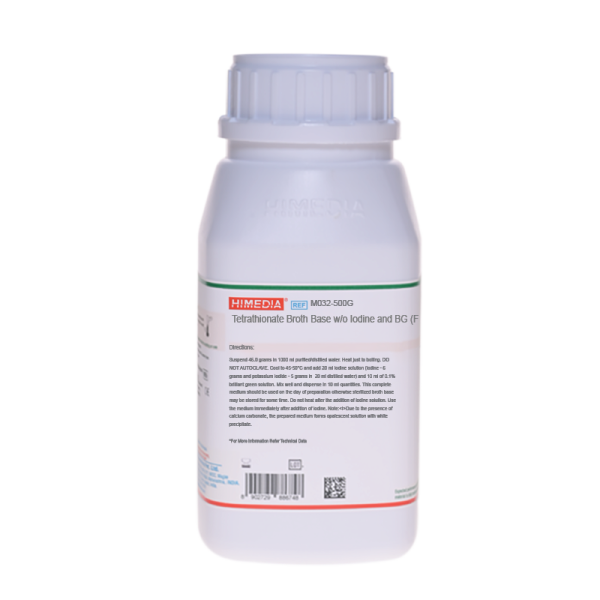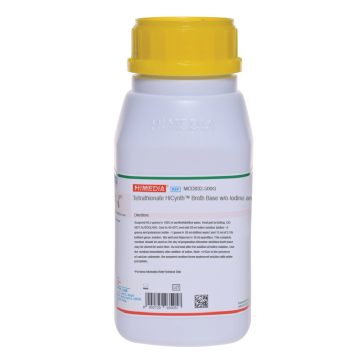 Your enquiry has been submitted
Your enquiry has been submitted
Fluid Tetrathionate Medium w/o Iodine and BG (Tetrathionate Broth Base w/o Iodine and BG)
Plesiomonas shigelloides#CC293D
Intended Use
A selective enrichment medium for isolating Salmonellae from food and other pathological materials.
Composition**
| Ingredients | g/L |
|---|---|
| Tryptone | 2.500 |
| Peptone | 2.500 |
| Bile salts | 1.000 |
| Calcium carbonate | 10.000 |
| Sodium thiosulphate | 30.000 |
**Formula adjusted, standardized to suit performance parameters
Directions
Suspend 46.0 grams in 1000 ml purified/distilled water and heat just to boiling. DO NOT AUTOCLAVE. Cool below 45°C and add 20 ml iodine solution (iodine - 6 grams and potassium iodide - 5 grams in 20 ml distilled water) and 10 ml of 0.1% brilliant green solution. Mix well and dispense in 10 ml quantities. This complete medium should be used on the day of preparation otherwise sterilized broth base may be stored for some time. Do not heat after the addition of iodine solution. Use the medium immediately after addition of iodine.
Note: Due to the presence of calcium carbonate, the prepared medium forms opalescent solution with white precipitate.
Principle And Interpretation
Salmonella are ubiquitous in the environment. These organisms are usually present in small numbers compared to coliforms; therefore it is necessary to examine a relatively large sample to isolate the organisms (1). Salmonella present in food samples may be sub lethally damaged during various stages of food processing where they may be exposed to low temperatures, heat drying, radiations, various chemicals (2). These damaged cells are able to cause spoilage, and if ingested cause diseases under favorable conditions. Therefore it is important to resuscitate these damaged bacteria before enumeration. Fluid Tetrathionate Medium (with added iodine and brilliant green) is recommended for the selective enrichment of Salmonella including Salmonella Typhi from faeces, urine, food and other material of sanitary importance. The medium, originally formulated by Mueller (3) is recommended by APHA (4,5,6) for enrichment of Salmonella. Due to the addition of iodine and potassium iodide, tetrathionate is formed in the medium. Organisms possessing the enzyme tetrathionate reductase grow in this medium.
Tryptone and peptone are the sources of carbon, nitrogen, vitamins and minerals. Bile salts inhibit accompanying gram-positive microorganisms. The selectivity depends on the ability of thiosulphate and tetrathionate in combination to suppress commensal coliform organism (7,8). Calcium carbonate neutralizes the acidic tetrathionate decomposition products. Brilliant green also helps to select Salmonella by inhibiting the accompanying bacteria. For further confirmation, streak the enriched cultures after incubation, on plates of Brilliant Green Agar (M016), MacConkey Agar (M081) and Bismuth Sulphite Agar (M027).
Aseptically inoculate test specimen into Fluid Tetrathionate medium (with added iodine and brilliant green) and incubate at 35-37°C for 18-24 hours. Following the incubation, isolate onto selective media plates. Refer standard procedures for enrichment and isolation (4,5,6).
Type of specimen
Clinical specimen :faeces, urine, other material of sanitary importance, Food samples.
Specimen Collection and Handling
For clinical samples follow appropriate techniques for handling specimens as per established guidelines (9,10).
For food and dairy samples, follow appropriate techniques for sample collection and processing as per guidelines (6,11).
After use, contaminated materials must be sterilized by autoclaving before discarding.
Warning and Precautions
In Vitro diagnostic use. For professional use only. Read the label before opening the container. Wear protective gloves/protective clothing/eye protection/face protection. Follow good microbiological lab practices while handling specimens and culture. Standard precautions as per established guidelines should be followed while handling clinical specimens. Safety guidelines may be referred in individual safety data sheets.
Limitations
- For further confirmation, streak the enriched cultures after incubation, on plates of Brilliant Green Agar (M016), MacConkey Agar (M081) and Bismuth Sulphite Agar (M027).
Performance and Evaluation
Performance of the medium is expected when used as per the direction on the label within the expiry period when stored at recommended temperature.
Quality Control
Appearance: White to cream homogeneous free flowing powder
Colour and Clarity of prepared medium: Complete medium with added brilliant green and iodine solution - Light green coloured, opalescent solution with heavy white precipitate, which on standing the precipitate settles down.
Cultural Response
Cultural characteristics observed with added brilliant green and iodine solution when sub cultured on MacConkey Agar (M081) after enrichment in Tetrathionate medium, after an incubation at 35-37°C for 18-24 hours.
| Organism | Inoculum (CFU) | Recovery | Colour of colony |
|---|---|---|---|
| Escherichia coli ATCC 25922 (00013*) | 50-100 | little or no increase in number | pink-red with bile precipitate |
| Salmonella Choleraesuis ATCC 12011 | 50-100 | good-excellent | colourless |
| Salmonella Typhi ATCC 6539 | 50-100 | good-excellent | colourless |
| Salmonella Typhimurium ATCC 14028 (00031*) | 50-100 | good-excellent | colourless |
| Escherichia coli ATCC 8739 (00012*) | 50-100 | little or no increase in numbers | pink-red with bile precipitate |
Key: *Corresponding WDCM numbers.
Storage and Shelf Life
Store between 10-30°C in a tightly closed container and use freshly prepared medium. Use before expiry date on the label. On opening, product should be properly stored dry, after tightly capping the bottle in order to prevent lump formation due to the hygroscopic nature of the product. Improper storage of the product may lead to lump formation. Store in dry ventilated area protected from extremes of temperature and sources of ignition Seal the container tightly after use. Product performance is best if used within stated expiry period.
Disposal
User must ensure safe disposal by autoclaving and/or incineration of used or unusable preparations of this product. Follow established laboratory procedures in disposing of infectious materials and material that comes into contact with clinical sample must be decontaminated and disposed of in accordance with current laboratory techniques (9,10).
Reference
- Cherry et al, 1972, Appl. Microbiol., 24:334
- Hartman and Minich, 1981, J. Food and Prot., 44:385
- Mueller, 1923, Compt. Rend. Sco. Biol., 89:434.
- Lipps WC, Braun-Howland EB, Baxter TE, eds. Standard methods for the Examination of Water and Wastewater, 24th ed. Washington DC:APHA Press; 2023.
- Salfinger Y., and Tortorello M.L., 2015, Compendium of Methods for the Microbiological Examination of Foods, 5th Ed., American Public Health Association, Washington, D.C.
- MacFaddin J. F., 1985, Media for Isolation-Cultivation-Identification-Maintenance of Medical Bacteria, Vol. 1, Williams and Wilkins, Baltimore.
- Pollock M. R. and Knor R., 1943, Biochem J., 37:476.
- Isenberg, H.D. Clinical Microbiology Procedures Handbook 2nd Edition.
- Jorgensen, J.H., Pfaller, M.A., Carroll, K.C., Funke, G., Landry, M.L., Richter, S.S and Warnock., D.W. (2015) Manual of Clinical Microbiology, 11th Edition. Vol. 1.
- American Public Health Association, Standard Methods for the Examination of Dairy Products, 1978, 14th Ed., Washington D.C.
| Product Name | Fluid Tetrathionate Medium w/o Iodine and BG (Tetrathionate Broth Base w/o Iodine and BG) |
|---|---|
| SKU | M032 |
| Product Type | Regular |
| Physical Form | Powder |
| Origin | Animal |
| Packaging type | HDPE |
| References | 1. Cherry et al, 1972, Appl. Microbiol., 24:334 2.Hartman and Minich, 1981, J. Food and Prot., 44:385 3.Mueller, 1923, Compt. Rend. Sco. Biol., 89:434. 4.Salfinger Y., and Tortorello M.L. Fifth (Ed.), 2015, Compendium of Methods for the Microbiological Examination ofFoods, 5th Ed., American Public Health Association, Washington, D.C.5 Baird R.B., Eaton A.D., and Rice E.W., (Eds.), 2015, Standard Methods for the Examination of Water andWastewater, 23rd ed., APHA, Washington, D.C. 6.FDA Bacteriological Analytical Manual, 2005, 18th Ed., AOAC, Washington, DC. 7.Pollock M. R. and Knor R., 1943, Biochem J., 37:476. 8.MacFaddin J. F., 1985, Media for Isolation-Cultivation-Identification-Maintenance of Medical Bacteria, Vol. 1, Williamsand Wilkins, Baltimore. 9.American Public Health Association, Standard Methods for the Examination of Dairy Products, 1978, 14th Ed., WashingtonD.C.10.Isenberg, H.D. Clinical Microbiology Procedures Handb0ook. 2nd Edition. 11.Jorgensen,J.H., Pfaller , M.A., Carroll, K.C., Funke, G., Landry, M.L., Richter, S.S and Warnock., D.W. (2015)Manual of Clinical Microbiology, 11th Edition. Vol. 1. |
| Customized Product Available | No |










